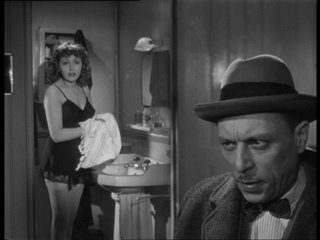D: Henri-Georges Clouzot
 Clouzot was often called the French Hitchcock, for he made two thrillers--Wages of Fear and Les Diaboliques--that Hitchcock would have shot and stuffed his mother to have made. Quai des Orfevres is one of his earliest films, and the title refers to the address where a murder takes place at the film's halfway point. Up until then, we meet four characters who circle each other like panthers: Marguerite, stage name "Jenny Lamour" (Suzy Delair), an earthy, forward showgirl who has no qualms in showing anything, Maurice Martineau (Bernard Blier), her dumpy husband and accompanist, Dora (Simone Renant), who makes some easy cash by snapping dirty pictures, and Dora's chief client, the sleazy George Brignon (Charles Dullin), who promises movie contracts to young tarts, and has his eyes on Marguerite. Maurice tries to keep the two separated, but Marguerite's ambition proves this to be impossible; when Brignon's body is turned up by the police, suspects hide their motivations, alibis are tested, and secret relationships are brought to the fore.
Clouzot was often called the French Hitchcock, for he made two thrillers--Wages of Fear and Les Diaboliques--that Hitchcock would have shot and stuffed his mother to have made. Quai des Orfevres is one of his earliest films, and the title refers to the address where a murder takes place at the film's halfway point. Up until then, we meet four characters who circle each other like panthers: Marguerite, stage name "Jenny Lamour" (Suzy Delair), an earthy, forward showgirl who has no qualms in showing anything, Maurice Martineau (Bernard Blier), her dumpy husband and accompanist, Dora (Simone Renant), who makes some easy cash by snapping dirty pictures, and Dora's chief client, the sleazy George Brignon (Charles Dullin), who promises movie contracts to young tarts, and has his eyes on Marguerite. Maurice tries to keep the two separated, but Marguerite's ambition proves this to be impossible; when Brignon's body is turned up by the police, suspects hide their motivations, alibis are tested, and secret relationships are brought to the fore.What makes this film special is not so much the plot--which is the kind you'd read in a cheap pulp novel from the same era--but the execution. Clouzot proves to be a master of detail. When Marguerite, as Jenny Lamour, steps into the audience and sings to a distracted female patron, you can almost see that customer roll her eyes as the showgirl walks away. In one of the many backstage moments, the viewer is struck by how naturally Clouzot depicts Marguerite wiping her armpits with a towel after a performance (in an earlier bit of dialogue, she confesses she sweats so much during a performance that her "panties are soaked"). Best of all is the portrayal of Dora; it's up to the viewer to decipher, from Clouzot's clues, that despite Marguerite's conviction that Dora is having an affair with Maurice, she really is in love with Marguerite.
Films like Quai des Orfevres help the modern viewer understand the sensational thrills American viewers must have had watching European cinema from the postwar period. While American films were locked into the Production Code, and were limited in sexual, drug-related, or violent content, Clouzot and his French contemporaries could get away with murder. There's a graphic suicide attempt, frank sexual dialogue, the aforementioned lesbianism (which really isn't as subtle as I made it out to be), and a moment when Marguerite seduces Maurice in her elaborately-garted lingerie--which is climaxed, so to speak, by a wry bit of symbolism.
The style is equally impressive. Wellesian moments of deep focus hold the attention during long dialogue scenes, and enhance the paranoia (when even someone lurking in the background can be in sharp focus, all eyes must be watching). Another trick to enhance what might otherwise be a dull cross-exchange between characters is the use of a practicing string section that provides their own score; at one point, one of the violinists approaches the frame and it seems almost malevolent. And after an intense police interrogation in which the suspect finally breaks down, the tension is maintained and played with as the police drag their suspect out of the room into the crowd of reporters waiting outside, and the reporters chase them so ecstatically that a few tumble headfirst down the stairs. For a film preoccupied with the details of passion, it seems like a summarizing moment.

Hiç yorum yok:
Yorum Gönder